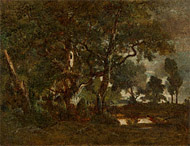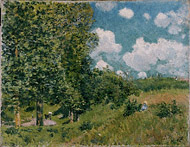
|
||
The Academic Tradition
By the 19th century, the art world in France had been controlled for over two centuries by the powerful national art academy, the Royal Academy of Art. The origins of the Royal Academy of Art in France (in French, École des Beaux-Arts) go back to 1648 when it was founded by Cardinal Mazarin for King Louis XIV. The Academy was set up to train the most talented students in drawing, painting, sculpture, and architecture. Over time, it became a powerful organization that controlled both what was taught and what was exhibited in France. The curriculum required students to prove their skills with basic drawing tasks before advancing to figure drawing and painting. When artists submitted works to the annual Salon (a school-sponsored, juried exhibition) it was understood that the highest awards went to artists who depicted historical subjects, while genres such as landscape and still life were seen as less important subject matter.
The Barbizon School
A group of painters now known as the Barbizon artists, named for the region of France that they worked in, began to turn increasingly towards landscape as a subject matter, painting outdoors, or en plein air, directly from nature. Previously, works of art had usually been painted in the artist’s studio. Artists such as Thèodore Rousseau and Camille Corot chose subjects such as forest scenes, fields, and villages. These artists influenced many of the younger artists who would later become known as the Impressionists. Because of their choices for subjects, painters such as Rousseau had difficulty getting their work into the annual Salon. Inclusion in the Salon was crucial to an artist’s success because it solidified his or her reputation in the art world.

|
||
The Rise of Impressionism
By the 1860s, the rift between Salon-accepted artists and those artists working in new modes of landscape painting had grown wider. Artists accused the jury for the annual Salon of rejecting works that were not deemed to fit the academic model. In 1863, in response to the complaints about the number of rejections from the Salon, French Emperor Napoleon III created the first exhibition of the Salon des Refusès, to include works by those refused by the Salon jury. Many of the works by those to be associated with the Impressionist movement were exhibited there.
In 1874, 30 artists banded together to show their work without the sanction of the government and without a jury. They named themselves the Sociètè Anonyme des Artistes Peintres, Sculpteurs, Graveurs, etc., and staged their exhibition in the former studio of the photographer Nadar (Gaspard Mix Tournachon) in Paris. The group included Paul Cèzanne, Edgar Degas, Claude Monet, Berthe Morisot, Camille Pissarro, Pierre-Auguste Renoir, and Alfred Sisley. It was about this time that the name "Impressionist" was coined by an art critic responding to one of Monet’s landscape paintings, Impression, Sunrise. The name was originally meant as a derogatory term, but it was soon adopted by the painters, and by 1877 they were using it as an identifier of their style and their exhibitions.
In the work of the Impressionists, landscape scenes dominate, but they were also known for scenes of urban subject matter and people in various forms of recreation, including boating and strolling along rivers and across bridges. The artists were also influenced by Japanese prints and began incorporating compositions that emphasized asymmetry.